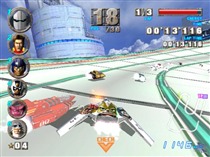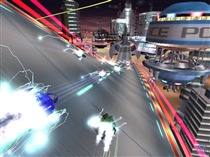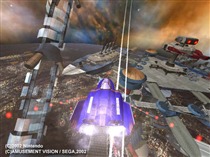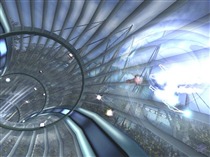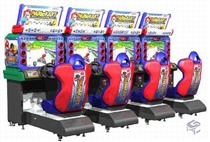We take a look back at the games worthy enough to be considered the GameCube's best.


F-Zero GX
Released August 26, 2003
Developed by Amusement Vision
Published by Nintendo
Retrospective by Jon Lindemann
With origins dating back to the days of the Super NES, the F-Zero series chronicles the futuristic exploits of drivers in the high-speed and high-risk F-Zero Racing League. Its GameCube incarnation, F-Zero GX, arrived on the console in late 2003. It really showed how far the series had come in its twelve-year lifespan, and justified why the F-Zero series is widely regarded as the best "futuristic" racing series ever (even outshining other strong franchises like Extreme-G and Wipeout). GX took its rightful place as the best game in the series, and one of the best in the entire GameCube library.
F-Zero GX was the product of a once-unthinkable partnership between Nintendo and Sega. Developed by Amusement Vision, the Sega second-party developer responsible for the Super Monkey Ball series, it remains the epitome of high production values from top to bottom. Each of its more than twenty tracks has its own stylish and futuristic look, offering beautiful 3D environments including wide oceans, endless sands, ancient forests, and blazing lava lakes. Giant fish swim through underwater levels, and massive sand worms leap over you in the middle of alien deserts. It only takes a few races for players to realize that F-Zero GX is a visual masterpiece that stands up well even against today’s most beautiful games.
It’s also blisteringly fast, letting players achieve speeds exceeding 2000km/h (of course, this is the future, where everybody appears to have embraced the logic of the metric system) and actually feel like they’re doing it. The power of the GameCube helps in this regard, but so does the intentionally simple ship design. Each vehicle looks great, but features relatively low polygon counts; this is because the development team wanted to ensure that all thirty ships in a race – you heard right, thirty – could be shown on-screen at once. More than any racing game before it, F-Zero GX puts you in the thick of the action. There’s nothing more satisfying than boosting past twenty-nine other racers, knocking the front runners out with a well-timed spin attack, and taking the checkered flag in improbable fashion.
While thirty vehicles can be involved in a race at any one time, more than forty are available. What’s even more impressive is that each one has a driver with his/her/its own background profile and theme song, testament to Amusement Vision’s attention to detail as well as their incredible sound and music design. F-Zero GX separated itself from its predecessors with its wealth of characters, showing a clear intent to build a "universe" that future installments in the franchise could be built around. It was the first F-Zero game to feature a story mode, establishing intergalactic bounty hunter Captain Falcon as the game’s "hero" and filling in some back story for series stalwarts like Dr. Stewart, Jody Summer, and Samurai Goroh. Later games like F-Zero GP Legend (GBA) built on this foundation, and an animated F-Zero series extended the story even further. In a sense, F-Zero GX elevated the franchise to elite status by crafting a world with enough depth to spin off entirely new games.
Speaking of depth, F-Zero GX has plenty of it in the gameplay department. In addition to the aforementioned Story Mode there’s Grand Prix, Vs. Battle (with four-player multiplayer), Time Trial, and Practice Modes. You can customize your ship and even create your own emblem to put on it. On top of all that, there are several difficulty levels, five different circuits, and a ton of ships and courses to unlock. You can play GX for weeks and never get tired of it. About the only thing missing is LAN play, but that’s not surprising since the functionality was woefully underused in the GameCube era.
Few racing games can match F-Zero GX’s pure speed, tight gameplay, beautiful graphics, killer soundtrack, wealth of gameplay options, and huge roster of vehicles and characters. Add in the unique ability to interact with its arcade cousin, and you have all the reasons why F-Zero GX races to the top of our list as one of the best GameCube titles ever released.
Thoughts From the NWR Staff
Michael Cole: "Mean-spirited by design, most who approach her throw their controllers in a fiery blaze of fury as their precious machine drifts to the abyss one too many times, or Black Shadow's bomb goes s'plodey yet again. But the very same know they can win if they stretch their limits just a little, and so they continue to scratch away at their agonizing victory. God I love this game."
Mike Sklens: "I remember the designer of this game at Sega saying he described it as 'Hot Neon Sex'. He was right. F-Zero GX is lighting fast and soaked in future-style. It's also hard as hell. To this day I cannot believe how damn fast this game is. Ninja-like reflexes are required, as this game will keep you on the edge of your seat the whole time."
Daniel Bloodworth: "This crazy collaboration between Sega and Nintendo brought together the
ultimate vision for F-Zero. The N64 game raised the bar for speed, track
designs, and traffic, but detailed graphics had to be sacrificed to pull it
off. F-Zero GX took those blisteringly fast races and combined them with
some of the best looking graphics ever seen on GameCube, as well as one of
the coolest soundtracks."
Steven Rodriguez: "If you're still not convinced at how impressive F-Zero GX is, I urge you to watch this video on YouTube, where someone uses an Action Replay to jack up the maximum speed to ludicrous levels. But you know what happens? The frame rate stays smooth the whole way through. Other games may claim to have the proverbial "rock solid" 60fps, but GX is the only game I know where it stays that way no matter what is going on. Because of its amazing consistency, it remains one of the fastest racing games ever made."
Jonathan Metts: "This game had me in its death grip until I hit a solid brick wall of difficulty. I just got to a point where I could not progress in ANY of the modes, and unfortunately it was not so much losing races but rather being knocked off the courses by kamikaze A.I. opponents. F-Zero is still one of the most beautiful GameCube titles and a fantastic racing game."
Jon Lindemann: "I recently plugged in GX for the purposes of this article after not
playing it for more than a year, and I was blown away by its amazing
graphics, depth, and fun factor. It's one of the best racers I've
ever played, hands-down. Nintendo absolutely MUST make a Wii sequel
with online multiplayer. I'd pre-order that game a year in advance."
In early 2002 Nintendo, Namco, and Sega jointly announced that they were working on a system board to be used in a brand-new series of arcade games. Dubbed the Triforce, it was based on GameCube hardware but featured several notable upgrades like more installed memory, the ability to upgrade that memory, and the ability to support peripherals like Sega’s GD-ROM drive. The first game announced for the hardware was F-Zero AX.
F-Zero AX was an almost entirely new game featuring six unique tracks, a roster of ten new ships, and exclusive custom parts. Most importantly, F-Zero GX owners could bring their memory card to the arcade and transfer tracks, ships, and parts from the arcade to the home version. This saved GameCube gamers some time, since the only other way to unlock the AX elements in GX was to beat the game on the highest levels of difficulty. This arcade/home interaction was an ingenious way to extend the shelf life of the of the console game, while giving an entirely new audience a reason to visit their local arcade. The GameCube-Triforce connection continues to the present day, with the GameCube’s Mario Kart Double Dash serving as a foundation for the Triforce-enhanced arcade title Mario Kart Arcade GP, which is due for a sequel soon.

